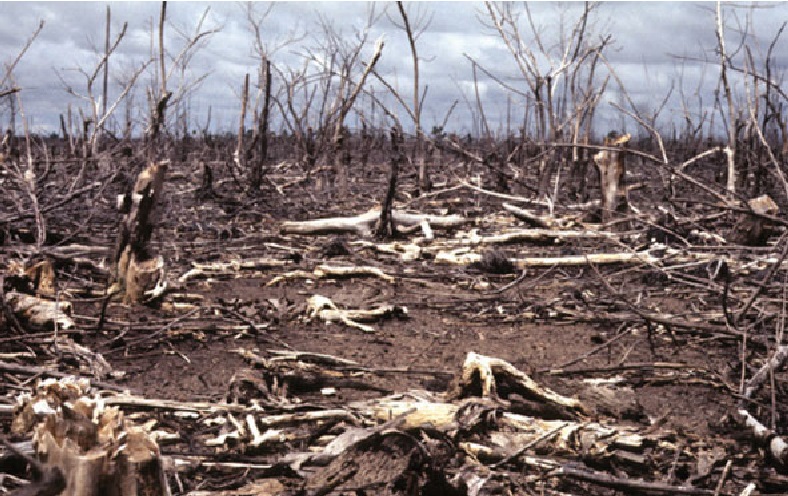
Scholars of peace and security divide peace into positive and negative peace. Negative peace is the absence of war or direct military confrontation while positive peace is the presence of social harmony and the absence of structural conflict. The scholars classify drought, poverty, environmental degradation and environmental instability as structural causes of conflict where it affects the social harmony and livelihood of the society. For peace and conflict scholars Structural violence is violence where it harms people by averting them from addressing their basic needs or that disturbs the social harmony of people and societies.
Environmental degradation by itself is a structural problem that affects the ‘just peace’, at the same time this structural conflict is triggered by the absence of negative peace or due to active war where it damages the environmental nature, natural resources and forests. The environmental impacts of war are multidimensional; at the same time remain for a long period since curbing the environmental impacts takes huge resources and time.
War is devastating. Its human and material costs and damages are shocking. Beyond its human cost, material and resource damages and destructions during the active military confrontation, its environmental impact is more harmful as its impacts may pass generations.
A paper entitled “Climate-related security risks and peace-building in Somalia” stated that continuous civil war in Somalia affects the environment of the country which highly affected Somalia’s food and water insecurity over the past two decades. The impact of climate change has triggered the degree of Somalia’s food and water crises, compounded by land mismanagement, and forced people to use charcoal and other wood products for income and halting environmental conservation mechanisms due to instability.
Most of the time, people do not understand the devastating impacts and harms of the war on environmental and natural resources. But, beyond the material and human life costs of direct conflicts during the war, the environmental damage is beyond imagination since its impacts remain for a long period and the recovery mechanism is too expensive.
During the active war, burning of forests, resource extraction, weaponization of environmental information, environmental pollution, environmental damages during occupations and the damage to capture stronghold and military fortresses affects the environment hugely. Not only that, suspensions of recovery projects and programs, limitations to fulfill national promises and obligations to achieve plans and goals related to climate, resource grabs and weak state control affects to protect the available natural ecology and the efforts of recovery, conservation and curbing mechanisms.
Conflict is the main cause of human displacement in Africa, especially in the Horn of Africa. The displacement of people from their residential areas forced them to relocate to new areas that affected the newly overpopulated areas unmanageably and use natural resources unwisely for their survival. The destruction of residential houses, halting of investments, and destruction of common resources like energy also forced the people to cut forests to build new residential houses, to sell charcoal and wood as income-generating and for their energy consumptions.
In addition, in societies where there is a culture of conservation mechanisms, wars forced the people to stop the environmental protection and conservation mechanisms since they focus on their survival.
War consumes and destructs huge natural resources and damages forests and environments during active military engagements. In addition, during the active confrontation, the displacement of people from place to place affects the environmental safety and nature and also causes another security threat.
Beyond the direct impacts during the active confrontations, the impacts that happen following the end of the wars births droughts, hunger and famine. To withdraw from the devastating impacts of the war, people focus on exploiting the natural resources including natural forests unwisely and traditionally. Not only that, after active wars, the environment sector and forest protection do not get attention from governments since governments become busy resettling displaced peoples, restoring destroyed infrastructure, recovering the economy and other social and political hot agendas.
Hence, after wars, environmental conservation, reforestation and other environmental protection mechanisms do not get attention for a long period. Wars consume huge economic resources of the society and the countries in general. Hence, in countries that pass through active wars, most of the time the post-war period faces hunger, famine and droughts especially in developing countries. To fight famine and hunger after wars, countries and societies hugely use the available natural resources. Not only that, there is not enough budget to allocate for the conservation and protection of the environment.
Considering the devastating impacts of war and active military confrontation on the environment, the UN declared November 6th as the International Day for Preventing the exploitation of the environment in war and armed conflict in 2001. It underlines that environment is highly affected by war and increasingly contribute to further instability.
During post-war recovery efforts, countries and societies should consider the environmental protection and environmental conservation mechanisms to make the recovery efforts fruitful and to achieve the target goal of withdrawing from the overall effects of wars economically, socially and politically.
BY DARGIE KAHSAY
THE ETHIOPIAN HERALD NOVEMBEBER 16/2021





